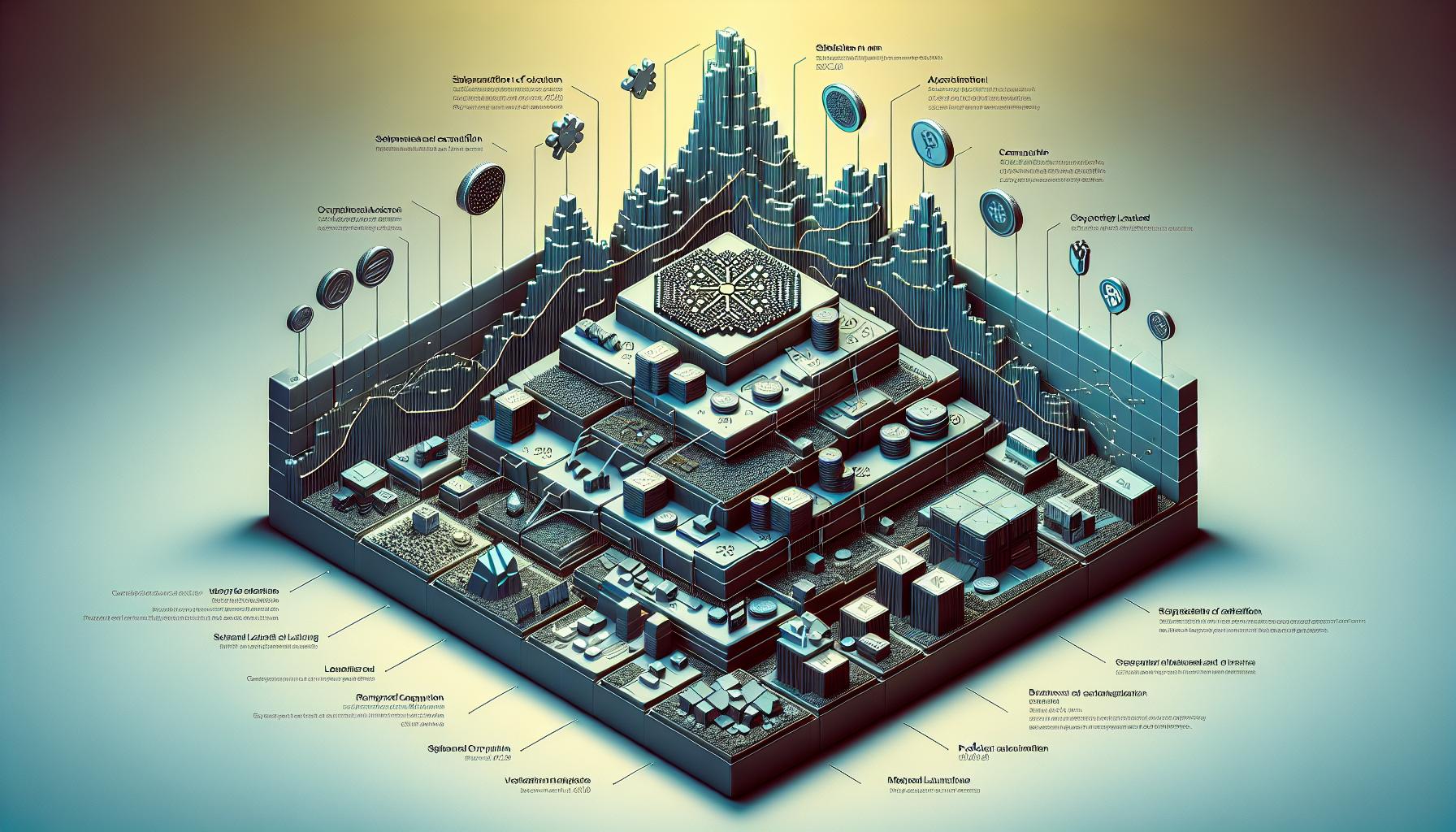Key Takeaways
- Third Most Popular Cryptocurrency: Cardano (ADA) ranks as the third most popular cryptocurrency as of October 2023, showcasing its growing significance in the cryptocurrency market.
- Innovative Technology: Cardano’s unique layered architecture enhances security and scalability, making it a robust platform for decentralized applications and smart contracts.
- Proof-of-Stake Mechanism: Utilizing the Ouroboros proof-of-stake consensus mechanism, Cardano promotes energy efficiency and allows users to earn rewards by participating in the network.
- Community-Centric Governance: Cardano’s inclusive governance model fosters active community engagement, promoting transparency and adaptability to user needs.
- Real-World Use Cases: The platform supports various applications, including DeFi, supply chain management, healthcare solutions, and digital identity verification, demonstrating its versatility.
- Consistent Market Performance: With a market capitalization exceeding $10 billion, Cardano maintains a strong competitive position in the cryptocurrency landscape, attracting investor interest and institutional partnerships.
In the ever-evolving world of cryptocurrency, the race for dominance is fierce. While Bitcoin and Ethereum often steal the spotlight, the third most popular cryptocurrency has carved out a significant niche for itself. This digital asset not only showcases innovative technology but also attracts a dedicated community of investors and enthusiasts eager to explore its potential.
As the market continues to mature, understanding the dynamics of this cryptocurrency becomes crucial for anyone looking to navigate the digital finance landscape. With unique features and growing adoption, it stands poised to influence the future of finance. Let’s dive deeper into what makes this cryptocurrency a standout contender in the bustling crypto arena.
3rd Most Popular Cryptocurrency
The third most popular cryptocurrency, as of October 2023, is Cardano (ADA). Cardano focuses on providing a secure and scalable platform for the development of decentralized applications (dApps) and smart contracts. Its layered architecture separates the processing of transactions from the computation of smart contracts, enhancing security and efficiency.
Cardano utilizes a unique proof-of-stake (PoS) consensus mechanism called Ouroboros. This system allows users to earn rewards by participating in the network, promoting energy efficiency and reducing carbon footprint compared to traditional proof-of-work (PoW) systems.
The project emphasizes a research-driven approach, with academic collaboration driving its development. Cardano’s commitment to peer-reviewed research ensures that its technological advancements are built on sound principles and rigorous testing.
Cardano’s community plays a vital role in its growth. Developers, stakeholders, and users actively engage in discussions and decisions, fostering a sense of inclusivity. This governance model supports transparency and adaptability, aligning with the evolving needs of its users.
As of now, Cardano’s market capitalization positions it as a significant contender in the crypto space. Its strategic partnerships and ongoing ecosystem development illustrate its potential to influence the future of decentralized finance (DeFi) and blockchain technology.
Historical Context

Cardano’s journey in the cryptocurrency space reflects a commitment to innovation and research. The project’s foundation and development are marked by significant milestones that shape its trajectory.
Genesis and Early Development
Cardano launched in September 2017, initiated by Input Output Hong Kong (IOHK) under the leadership of Charles Hoskinson, a co-founder of Ethereum. The platform introduced a distinct layered architecture, separating the settlement and computation layers, which enhanced scalability and flexibility. The development process prioritizes peer-reviewed research, allowing the team to build upon solid theoretical frameworks. Cardano’s early development focused on creating a sustainable ecosystem for decentralized applications and smart contracts.
Key Milestones
Several key milestones punctuate Cardano’s evolution:
| Year | Milestone |
|---|---|
| 2017 | Cardano launched; initial coin offering (ICO) raised $62 million. |
| 2018 | Implementation of the Cardano Settlement Layer (CSL). |
| 2020 | Launch of the Shelley upgrade, enabling the proof-of-stake mechanism. |
| 2021 | Introduction of smart contracts with the Alonzo upgrade. |
| 2022 | Expansion of decentralized finance (DeFi) initiatives and partnerships. |
These milestones demonstrate Cardano’s steady growth and its role in advancing blockchain technology. Each significant achievement aligns with a vision of building a robust and scalable platform for users and developers alike.
Features and Technology

Cardano’s technology and features set it apart in the competitive cryptocurrency space, focusing on security, scalability, and sustainability. Its innovative architecture supports a diverse range of applications, solidifying its position as a leader in decentralized finance.
Blockchain Structure
Cardano utilizes a unique layered architecture, consisting of two primary layers: the Cardano Settlement Layer (CSL) and the Cardano Computation Layer (CCL). The CSL handles cryptocurrency transactions, ensuring secure and efficient value transfers. The CCL, in turn, focuses on executing smart contracts and decentralized applications (dApps). This separation enhances scalability, allowing developers to create and deploy robust applications without congesting the transaction layer.
Additionally, the use of the Extended UTXO (EUTXO) model improves security and allows for complex scripting capabilities. This model facilitates greater flexibility in transaction execution, which is crucial for developers building innovative dApps on the Cardano platform.
Consensus Mechanism
Cardano employs the Ouroboros proof-of-stake (PoS) consensus mechanism, which replaces the energy-intensive proof-of-work (PoW) model. Ouroboros enhances network security while promoting environmental sustainability by lowering energy consumption. The mechanism divides time into epochs and slots, allowing stakeholders to participate in the validation process based on the amount of ADA (Cardano’s cryptocurrency) they hold.
Ouroboros guarantees decentralization through a random selection process, providing fairness in the block creation process. This efficient design not only strengthens the network but also rewards participants for their contributions, fostering an active community that drives innovation.
Market Performance

Cardano (ADA) exhibits noteworthy market performance as the third most popular cryptocurrency. Its price movements and market capitalization reflect its growing influence within the crypto ecosystem.
Price Trends
Cardano’s price performance is characterized by volatility, common across the cryptocurrency market. As of October 2023, ADA’s price fluctuated between $0.30 and $0.70 over the last year. Following pivotal upgrades, such as the Alonzo smart contract implementation, significant price surges occurred, showcasing investor interest in its technological advancements. Throughout 2022, Cardano encountered notable bearish trends, dipping below $0.40, but signs of recovery began in early 2023, driven by broader market optimism and increasing adoption.
Market Capitalization
Cardano’s market capitalization consistently ranks among the top cryptocurrencies, often exceeding $10 billion. As of September 2023, it maintained a market cap of approximately $12 billion, reflecting sustained investor confidence. This capitalization positions Cardano as a formidable player in the decentralized finance landscape, attracting institutional interest and fostering strategic partnerships. The strong market capitalization also enables Cardano to compete effectively against established cryptocurrencies like Bitcoin and Ethereum.
Use Cases and Adoption
Cardano (ADA) showcases various use cases that reflect its growing adoption in different sectors. Its technology supports innovative applications, expanding its user base and community.
Real-World Applications
Cardano’s versatile platform enables multiple real-world applications across sectors.
- Decentralized Finance (DeFi): Cardano facilitates decentralized exchanges (DEXs) and lending platforms, providing users with financial services without intermediaries.
- Supply Chain Management: Companies use Cardano’s blockchain to ensure transparency and traceability in supply chains, enhancing product authenticity.
- Healthcare Solutions: Cardano supports secure patient data management and sharing, improving healthcare outcomes through efficient record-keeping.
- Digital Identity Verification: It offers a secure framework for identity management, safeguarding personal information while enabling users to verify credentials online.
These applications leverage Cardano’s security and scalability, reinforcing its position in practical use cases.
User Base and Community Growth
Cardano’s community has seen substantial growth, driven by active involvement and engagement.
- Developer Engagement: The community includes thousands of developers contributing to the ecosystem, creating dApps and enhancing Cardano’s functionality.
- Stakeholder Participation: Users actively participate in the governance model, voting on protocol improvements and ensuring decentralization.
- Educational Initiatives: Cardano promotes education through workshops and resources, fostering awareness and attracting new users.
- Global Outreach: Cardano’s focus on global partnerships increases its reach, appealing to diverse markets and user demographics.
This community-driven approach strengthens Cardano’s ecosystem, supporting its continuous growth and adoption in the cryptocurrency landscape.
Cardano Stands Out as a Significant Player in The Cryptocurrency Market
Cardano stands out as a significant player in the cryptocurrency market. Its innovative technology and research-driven approach pave the way for a sustainable future in decentralized finance. The commitment to security scalability and community engagement enhances its appeal among investors and developers alike.
With its unique features and robust ecosystem Cardano is well-positioned to adapt to the evolving landscape of digital assets. As adoption continues to grow across various sectors its influence in the blockchain space will likely expand further. Cardano’s journey reflects the potential of cryptocurrencies to reshape industries and empower users around the globe.